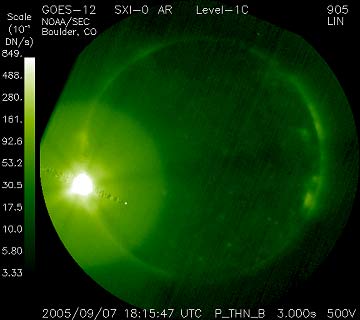Sun Kicks Up Major Flare, More Expected

The Sun kicked up one of the largest flares on record Wednesday and more eruptions are likely in coming days, forecasters said.
Communications and satellite operations could be affected over the next two weeks.
The flare was rated an X-17. All X-flares are major, and few have been recorded that were larger than X-10. It erupted from a sunspot that was on the limb of the Sun, so while X-rays and other radiation reached Earth in minutes, the bulk of the matter blown out from the site was not directed our way.
"This flare, the fourth largest in the last 15 years, erupted just as the Region 808 sunspot cluster was rotating onto the visible disk of the Sun," said Larry Combs, solar forecaster at the NOAA Space Environment Center.
It still had a significant impact.
"This event created a complete blackout of high frequency communications on the daylit side of Earth, which included the entire U.S. and basically anywhere the sun was shinning at this time," Combs said. "Communications used by emergency services along the Gulf Coast may have experienced problems due to this flare. Low frequency navigation systems may also have experienced a period of significant degradation."
The flare was observed at 1:40 p.m. ET Wednesday.
Breaking space news, the latest updates on rocket launches, skywatching events and more!
Major flares are typically accompanied by coronal mass ejections, which take from several hours up to a couple days to arrive. These ejections of charged particles race outward in an expanding bubble. When they interact with Earth's magnetic field, they can disable satellites, generate colorful lights called auroras, and even trip power grids on Earth.
Because Wednesday's eruption was pointed away from Earth, the expanding bubble was not expected to produce more than a glancing blow to the planet.
But as the sunspot rotates onto the face of the Sun, further eruptions could have significant impact, forecasters said. Sunspots are regions of pent-up magnetic energy. They are darker and cooler than the rest of the solar surface.
The Sun is currently at a low point in its 11-year cycle of activity. While sunspots and flares are less common now, astronomers say they can pack plenty of punch when they do occur.
The largest flare in modern times was recorded in November 2003 and was estimated to be an X-40. It, too, was on the limb of the Sun and so its full impact was not felt on Earth.
- Live Sun Cam
- Speed Limit Found For Solar Storms
- Key to Solar Storms Found, Better Forecasts Expected
- The Great Storm: Solar Tempest of 1859 Revealed
- Mysteries of the Sun

Rob has been producing internet content since the mid-1990s. He was a writer, editor and Director of Site Operations at Space.com starting in 1999. He served as Managing Editor of LiveScience since its launch in 2004. He then oversaw news operations for the Space.com's then-parent company TechMediaNetwork's growing suite of technology, science and business news sites. Prior to joining the company, Rob was an editor at The Star-Ledger in New Jersey. He has a journalism degree from Humboldt State University in California, is an author and also writes for Medium.
